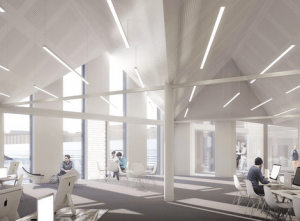Architects have the power to define the atmosphere in a building, shaping the experience of visitors. If we are successful, we can make people feel comfortable, encourage contemplation, boost productivity, and much more. Two crucial elements to think about here are light and shadow. They are key fundamentals, especially if you want to design commercial architecture or public spaces people love.
A famous example
There are lots of fantastic examples of how important light and shadow is for shaping the atmosphere. Arguably the most famous is the Pantheon. The ancient temple in Rome is one of the most significant and influential pieces of architecture in the West. The rotunda still has the record as the largest unreinforced concrete dome in the world.
The impact of light and shadow is easy to see in the Pantheon. The oculus allows daylight to enter from the top of the rotunda. It shines on the interior of the incredible dome, creating a sense of divinity. As a result, the atmosphere feels spiritual.
Using light
 The most important thing to keep in mind is a building isn’t a habitable space without light. You need illumination to define the spaces. It also influences mood and well-being. Whether it is an ancient temple or church, a modern office, a library or art gallery, or a home, lighting is absolutely crucial.
The most important thing to keep in mind is a building isn’t a habitable space without light. You need illumination to define the spaces. It also influences mood and well-being. Whether it is an ancient temple or church, a modern office, a library or art gallery, or a home, lighting is absolutely crucial.
One thing every architect should look at, especially when designing commercial architecture, is how to use natural daylight. It can ensure visual comfort, boost energy efficiency, and achieve the right atmosphere. This can lead to more openness, collaboration, and engagement. For example, you may want natural daylight to diffuse through the space to achieve a balance of light, ensuring there are no harsh contrasts.
While natural light offers many benefits, artificial illumination is just as important. It actually has some benefits too. Most importantly, it doesn’t fluctuate like daylight. Architects can therefore control every aspect, from the brightness to the hue and direction. It gives more power to sculpt the atmosphere in a space. In fact, the lighting almost becomes like a real, malleable material.
Shadow
Whenever you think about light, you naturally have to plan for shadow too. There is no way to avoid it. Even the brightest lights create shadows unless the space is entirely empty. It isn’t a bad thing though. In fact, shadow enhances depth and texture. It is fantastic for contrast too. It can add complexity and narrative, shaping the atmosphere.
One of the best things you can do is think about how shadow accentuates the texture of the materials. It can bring attention to their tactile qualities. Get it right and it creates layers to make the atmosphere more interesting and engaging. It can also aid transitions and movement.
Interplay
To really create an amazing atmosphere, you have to focus on the interplay of light and shadow. You can create dramatic contrasts or smoother transitions. It can make spaces immersive, contemplative, rich, dramatic, serene, and more. Most vitally, it can evoke different emotions. You can even use light and shadow to connect interior and exterior spaces.
Talk to us about light and shadow in commercial architecture
Coffey Architects has a real passion for using light and shadow as a key element of our designs. We can consider the impact in any kind of space, looking at crucial things like orientation, diffusion, light placement, and more. We can even do 3D modelling to show how light will play in a space.
So, if you want some help with commercial architecture, speak to us. We can work with you to ensure properties have the perfect atmosphere.